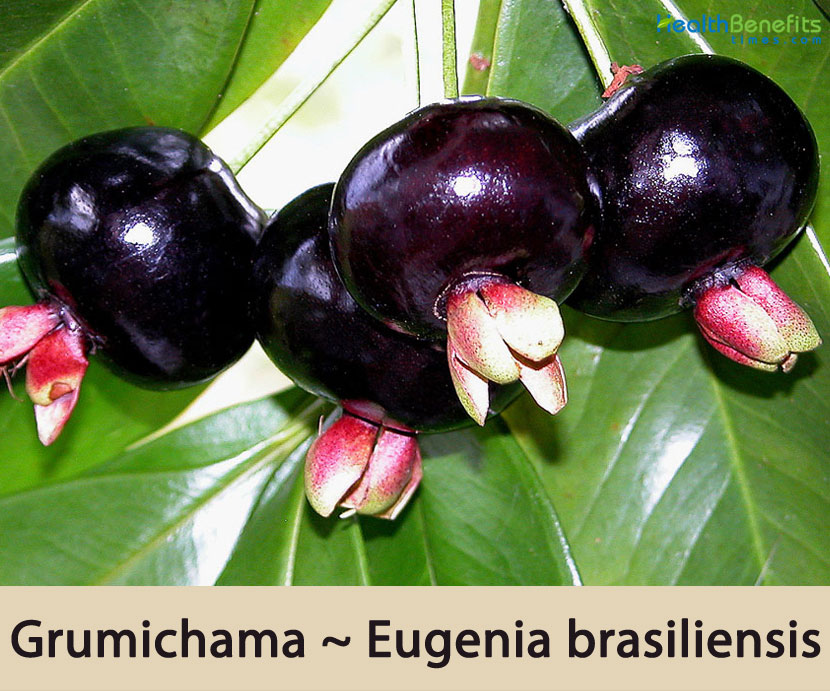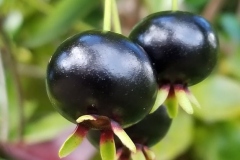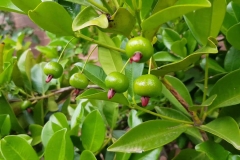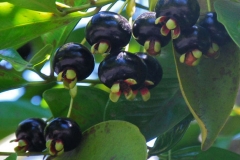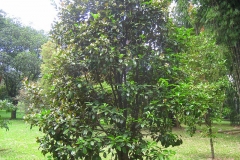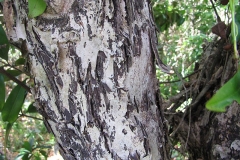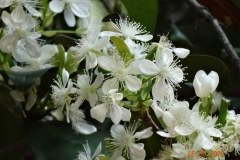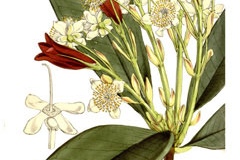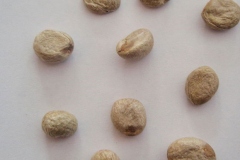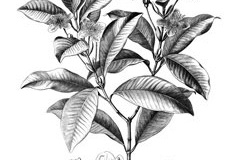| Grumichama Quick Facts | |
|---|---|
| Name: | Grumichama |
| Scientific Name: | Eugenia brasiliensis |
| Origin | Eastern and coastal southern Brazil, especially in the states of Parana and Santa Catarina |
| Colors | Initially green turning to bright-red and finally dark-purple to nearly black as it ripens |
| Shapes | Globose to oblate berry, 1.25 to 2.5 cm (0.5 to 1 in) in diameter |
| Flesh colors | White yellowish |
| Taste | Mild sub acid taste |
| Health benefits | Used for treating rheumatism and gastrointestinal disorders. |
| Name | Grumichama |
|---|---|
| Scientific Name | Eugenia brasiliensis |
| Native | Found wild in eastern and coastal southern Brazil, especially in the states of Parana and Santa Catarina |
| Common Names | Brazil Cherry, Brazilian Cherry, Grumichama, Red-Fleshed Grumichama, Spanish Cherry, Brazilian Plum, Grumixameira, Grumixama, Cumbixaba, Grumixaba, Grumixameira, Ibaporoti, Oula, Sinaili |
| Name in Other Languages | Arabic: Grumyshama (غروميشاما), ywjinat birazilia (يوجينة برازيلية) Brazil : Cumbixaba, Grumixama, Grumichameira, Grumixameira Catalan: Grumixama Chinese: Bāxī yīngtáo (巴西櫻桃) Czech : Hřebíčkovec Brazilský Danish : Brasiliansk Kirsebær English: Brazil-cherry, Grumichama, Red-fleshed grumichama, Brazilian plum, Spanish cherry French: Cerisier du Brésil, Jambosier du Brésil, Bois Dè Nefle Jambosier Du Brésil, cerieier du Japon, cerise du Brésil, pruneau German: Brasilianische Kirschmyrte, Brasilianische Ilocano: Grumichama Japanese: Burajirian cherī (ブラジリアン・チェリー ) Komi: Grumichama (Грумичама) Lak: Grumichama (Грумичама) Persian: گیلاس برزیلی Polish: Goździkowiec brazylijski Portuguese: Grumixaba, Grumixameira, Cumbixaba, Ibaporoiti, Grumixama, cerejeira-do-brasil Russian: Yevgeniya brazil’skaya (Евгения бразильская), Evgeniya brazil’skaya (Эвгения бразильская), Brazil’skaya vishnya (Бразильская вишня), Grumichama (Грумичама) Spanish: Cereza de Brasil, Grumichama, Grumichameira, Pomarosa Forastera Udmurt: Grumichama (Грумичама) |
| Plant Growth Habit | Attractive slender, tropical, evergreen shrub or small tree |
| Growing Climates | Atlantic rainforest, alluvial plains and gentle slopes |
| Soil | Thrives on acid soils such as deep fertile, sandy loams but will also grow on rich clays. It does best in full sun but will tolerate partial shade |
| Plant Size | Up to 14 m (45 ft.) tall. However, it is normally 3 to 7 m (10 to 23 ft.) |
| Root | Shallow root system |
| Bark | Greyish bark cracks and peels with age |
| Leaf | Opposite, oval-oblong, 9–16 cm long and 5–6 cm wide, simple with recurved margin, minutely pitted on both surface. Leaves are soft and wine red when they emerge and become dark glossy green with a leathery texture when mature |
| Flowering season | Starts from mid-March |
| Flower | Flowers are 1 in (2.5 cm) across, with four green sepals, four white petals and numerous erect, needle-like white stamens (about 100) each with a tiny, pale yellow, pollen-filled anther at the tip |
| Fruit Shape & Size | Globose to oblate berry, 1.25 to 2.5 cm (0.5 to 1 in) in diameter and bears the persistent, purple- or red-tinted sepals, (1.25 cm) long, at its apex. |
| Fruit Color | Initially green turning to bright-red and finally dark-purple to nearly black as it ripens |
| Fruit skin | Skin thin, firm and exudes dark-red juice |
| Flesh Color | White yellowish |
| Seeds | Seeds 1 more or less round, or 2 to 3 hemispherical, hard, light-tan or greenish-gray seeds to 1/2 in (1.25 cm) wide and half as thick. |
| Taste | Mild sub acid taste |
| Propagation | By seed or by cuttings or grafting |
| Season | April to May |
Plant Description
Grumichama is an attractive slender, tropical, evergreen shrub or small tree that normally grows up to 14 m (45 ft.) tall. However, it is normally 3 to 7 m (10 to 23 ft.) with a short squamous trunk and tufted branches, tinny and brittle supporting an oval or pyramidal crown. Its greyish bark cracks and peels with age. The short, cylindrical bole can be 25 – 40 cm in diameter. The plant is found growing in Atlantic rainforest, alluvial plains and gentle slopes. The plant thrives on acid soils such as deep fertile, sandy loams but will also grow on rich clays. It does best in full sun but will tolerate partial shade.
Leaves
Leaves are opposite, oval-oblong, 9–16 cm long and 5–6 cm wide, simple with recurved margin, minutely pitted on both surface. Leaves are soft and wine red when they emerge and become dark glossy green with a leathery texture when mature. They are usually shining dark green on the upper face while lighter on the underside. They are arranged in pairs along the ends of the branches and remain on the plant throughout the year.
Flower
Inflorescence in terminal clusters on branches, or borne singly in the leaf axils. Flowers are 1 in (2.5 cm) across, with four green sepals, four white petals and numerous erect, needle-like white stamens (about 100) each with a tiny, pale yellow, pollen-filled anther at the tip. They are perfect (with female and male parts) and bloom in large numbers on the tree. Flowering normally starts from mid-March.
Fruit
Fertile flowers are followed by fruit that are oblate, 1.25 to 2.5 cm (0.5 to 1 in) in diameter. Fruits are initially green turning to bright-red and finally dark-purple to nearly black as it ripens, and bears the persistent, purple- or red-tinted sepals, (1.25 cm) long, at its apex. The skin thin, firm and exudes dark-red juice. The red or white pulp is juicy and tastes much like a true sub acid or sweet cherry except for a touch of aromatic resin. There may be 1 more or less round, or 2 to 3 hemispherical, hard, light-tan or greenish-gray seeds to 1/2 in (1.25 cm) wide and half as thick. Fruit are born singly on new growth. As non-climacteric fruits, it must be harvested ripe. Frits are mostly used for fresh eating but can also be used in making jams, jellies and pies.
Traditional uses and benefits of Grumichama
- The bark and leaves consists of 1.5% of essential oil.
- In Brazil, the leaf or bark infusion in water is aromatic, astringent, diuretic and employed as a treatment for rheumatism and gastrointestinal disorders.
- It is an aromatic, astringent diuretic.
Culinary Uses
- The cherry like fruits are eaten fresh, candied or stewed.
- They are also utilized for the production of jelly, jam and pies.
- The fruit can be eaten raw.
- Ripe fruits are eaten out of hand or made into juices and marmalade.
- Seeded fruits are occasionally added to fruit salads.
- Sauce made of boiled fruits and sugar is used for pie fillings and cakes.
- Grumichama jelly and syrup can be found at some of Hawaii’s farmers’ markets.
- In the Caribbean, a reduction made from the juice of the fruit is used to accompany fish dishes.
- It can also be used as base for hot sauces.
- Processed puree is used in jam and jelly or in sauces.
Other Facts
- The small tree size favors its use in urban ornamental landscaping.
- Its wood is utilized in carpentry, woodworking and turnery.
- The bark contains about 43% tannin.
- The bark and leaves contain tannins and essential oil.
- Wood is easy to work, compact, hard, and moderately heavy and is used for cabinets, linings, boxes, and general carpentry.
References:
https://www.itis.gov/servlet/SingleRpt/SingleRpt?search_topic=TSN&search_value=506183#null
http://www.hear.org/pier/species/eugenia_brasiliensis.htm
https://npgsweb.ars-grin.gov/gringlobal/taxon/taxonomydetail?id=16148
https://pfaf.org/user/Plant.aspx?LatinName=Eugenia+brasiliensis
http://tropical.theferns.info/viewtropical.php?id=Eugenia+brasiliensis
https://gd.eppo.int/taxon/EUEDO
http://www.theplantlist.org/tpl1.1/record/kew-74560
https://en.wikipedia.org/wiki/Grumichama
https://www.growables.org/information/TropicalFruit/grumichamapage.htm
https://www.iplantz.com/plant/671/eugenia-brasiliensis/
https://www.cabi.org/isc/datasheet/23055
https://hort.purdue.edu/newcrop/morton/grumichama.html
https://plants.usda.gov/home/plantProfile?symbol=EUBR7


